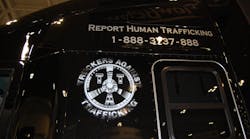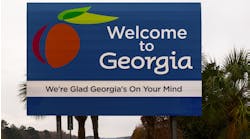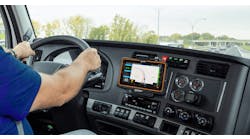Human trafficking is a modern form of slavery that’s trapping hundreds of thousands of people, many of them children, into forced commercial sex and abuse. It is also big business, worth some $150-billion-a-year criminal market globally. Truck drivers and fleet owners, however, can play a big role in stopping this horrific enterprise. To that end, Steven Spencer, vice president of transportation solutions at background screening company HireRight, and Laura Cyrus, operations director for Truckers Against Trafficking (TAT), offer some tips to help spot and stop trafficking.
The red flags of human trafficking might not be obvious, at first. But, a closer look into the faces and activities at truck stops, highway motels and rest areas across the country can reveal the victimization of countless women, men and even children.
There’s the strung-out boy who never leaves the sight of a controlling older man. Or the teenage girl, branded with a tattoo on the back of her neck. Or simply a distressed face glimpsed peering out from behind a darkened window.
Trucking companies, truck stop personnel, and especially truck drivers themselves, are on the frontlines of this global epidemic. They frequent or work at the truck stops and rest areas where traffickers force their victims – some as young as elementary age – into prostitution and subject them to constant physical and sexual abuse.
Because they’re constantly traveling and stopping at destinations also used by traffickers, transportation professionals can make a difference. Already trained to be aware of their surroundings, when truckers know how to identify potential human trafficking victims and how to get them help, they save lives.
Modern-day slavery
Human trafficking is a modern form of slavery that’s trapping hundreds of thousands into a life of forced commercial sex and abuse. Victims may have been kidnapped or recruited, sometimes online or during face-to-face meetings at schools, shopping centers or the street.
Sadly, it’s big business, fueling a $150-billion-a-year global criminal market. This crime has exceeded the illegal sale of arms and is expected to outstrip illicit drug sales, according to statistics compiled by the International Labor Organization (ILO).
And its victims are often very young. Anti-trafficking organizations don't agree on how many American children actually fall prey to human traffickers each year. But of the 18,500 runaways reported in 2016 to the National Center for Missing & Exploited Children, one in six were likely sex trafficking victims. Globally, the ILO says that 26% of the world's 21 million human trafficking victims are children.
This crime can take place at any location, but it is not uncommon at truck stops and welcome centers, which can be isolated from the broader community and serve transient customers, according to the Polaris Project, which works to eradicate modern slavery. These secluded locations also make it difficult for victims to escape. That’s where truckers can help.
Truckers to the rescue
Simply knowing the signs of human trafficking can make all the difference. Truckers should be on the lookout for warning signs, trust their gut and jot down notes, such as descriptions of vehicles and people; specific dates and times; and the address when something looks suspicious.
Specific red flags that likely signal a human trafficking case include:
- Any minor who appears to be engaged in the commercial sex trade.
- Anybody who appears to be under the control of a pimp, regardless of that person’s age or gender.
- Signs of branding or tattooing of the trafficker’s name, often on the neck.
- Indications of other abuse or drug addiction.
Once truckers have recognized the signs and identified a potential victim, time is of the essence. Truckers should immediately notify the truck stop manager and call the National Human Trafficking Hotline at 1-888-373-7888. The hotline is staffed 24/7 with trained operators who can relay information to local law enforcement and look for trends to turn over to the Federal Bureau of Investigation. Truckers also can call 911.
In nearly a decade, the hotline has received more than 1,830 calls specifically from people who identified themselves as truck drivers. Those calls uncovered 525 likely cases of human trafficking that involved 972 victims. About a third of those victims were minors.
Training is critical
Since the inception of Truckers Against Trafficking (TAT) in 2009, more truckers and trucking companies are getting involved in the work to end human trafficking.
An industry training program, designed specifically for truckers and truck-stop employees, is at the core of TAT’s work. The program, which is free, available online and takes no more than 30 minutes, highlights those red flags and others, along with ways that truckers can help.
So far, more than 453,000 people have completed the program. And a growing number of trucking companies are requiring their employees to get TAT trained. Many are making it a part of new driver orientation or screening the program during regular safety meetings.
What’s more, lawmakers are recognizing the value of the trucking industry in the fight against human trafficking. Ohio, Arkansas, Texas, Washington and Kansas now use TAT training as part of the curriculum for licensing either entry-level or all commercial drivers in their states. Other states are considering similar requirements.
But, ultimately, the biggest heroes in this fight will be the truckers.
They’re men and women like Con-way Truckload driver Kevin Kimmel, who called authorities in 2015 because something didn’t look quite right at a Virginia truck stop where he had stopped one morning. Through the darkened window of a recreational vehicle, he saw the face of a distraught young woman and, later, watched a man enter the vehicle, which, he told media, started “rocking and rolling.”
Thanks to his observations and subsequent call, police rescued the 20-year-old woman, who had been kidnapped by a couple two weeks earlier from Iowa. Physically and sexually abused and forced into prostitution, the woman was not far from death because of the injuries and starvation she endured.
Kimmel also received Truckers Against Trafficking’s 2015 Harriet Tubman Award, which honors those in the trucking industry whose direct actions help save or improve the lives of human trafficking victims.
He’d pulled into that truck stop to sleep. Instead, by following his instinct and not turning a blind eye, his call resulted in the rescue of a young woman from an unimaginable situation.



